|
BumblebeeID
- find British species by colour pattern
Distinguishing
similar species:
Unlike B. hortorum
and B. ruderatus, B.
subterraneus queens and workers (1) have very short even
hair, (2) usually have narrow pale fringes to abdominal segments
2 and 3, and (3) have the clypeus shining and almost without punctures;
and males can be distinguished by their
genitalia.
Unlike B. jonellus,
B. subterraneus (1) are very large with very short even
hair, (2) have the head longer than broad, and (3) queens and
workers have a spine on the mid basitarsus (see Prys-Jones &
Corbet, 1987, 1991).
Unlike B. campestris,
B. subterraneus pale males (1) have yellow faces, and (2)
can be distinguished by their
genitalia.
'Short-haired
Humble-bee'
(Sladen,
1912; Step, 1932)
'Short-haired
bumblebee'
(BBCT)
taxonomy
and nomenclature
|
A large
species with a long tongue, emerging in late spring, and
nesting below the surface of the ground. In its nest structure,
Sladen (1912) describes
it as a 'pocket-making' 'pollen-primer' species with a large
first brood. Colonies of this species are small.
|
| Habitat |
Flower-rich
heathland and grassland (Williams, 1988).
Probably also formerly in flower-rich low-intensity farmland.
|
|
British
distribution
|
England
and Wales, absent from Scotland and the Scilly Isles.
It has not been recorded since 1988 and may now
be extinct here (see declines).
Data from Alford (1980)
are mapped on a 10 km grid (left) to show local
patchiness and on a 50 km grid (right) to show changes
in the regional pattern (dark blue - post 1960;
light blue - pre 1960 only):
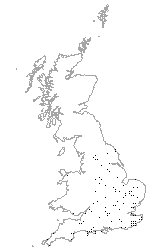 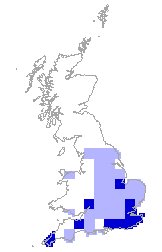
|
| Worldwide
distribution |
Indigenous
distribution in Europe east to Iran and from the
Tien Shan east to Mongolia. World distribution mapped
on an equal-area
grid (dark
blue - specimens identified by PHW; light blue -
literature records; white - expected distribution):
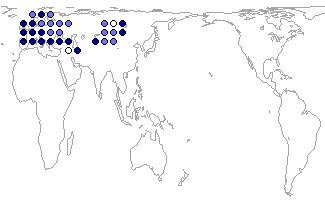
|
|
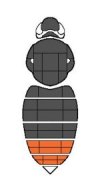
queen/worker
|
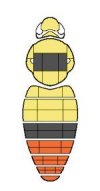
male |
|
|
|
Distinguishing
similar species:
Unlike B. lapidarius, B.
cullumanus queens and workers have the hind basitarsi without
many orange short feathered hairs on their outer surface (see
Prys-Jones & Corbet, 1987,
1991); and males (1) usually have brownish yellow face and
bands and (2) can be distinguished by their
genitalia.
Unlike B. ruderarius,
B. cullumanus queens and workers have the long hairs of
the pollen baskets (corbiculae) on the hind legs entirely black;
and males (1) have the face yellow and (2) the antennae are short.
Unlike B. pomorum and the dark form
of B. sylvarum,
B. cullumanus queens and workers have the mid basitarsi
with the posterior angle rounded without a spine (see Prys-Jones
& Corbet, 1987, 1991);
and males (1) have short antennae and (2) can be distinguished
by their
genitalia.
'Cullum's
Humble-bee'
(Sladen,
1912; Step, 1932)
taxonomy
and nomenclature
|
A medium-sized
species with a short tongue, emerging in late spring. In
its nest structure, Sladen (1912)
placed it in his group of 'pollen-storer' species, which
is undoubtedly correct, although the nest has not been described.
Most records are for males in August and September, but
a very few queens and workers have been collected (Yarrow,
1954; Alford, 1975).
|
| Habitat |
Chalk
grassland (Yarrow, 1954).
|
|
British
distribution
|
Southern
England, absent from Wales, Scotland and the Scilly Isles.
It has not been recorded since 'c. 1941' (BMNH collection)
and is probably extinct here (Alford, 1975).
Data from Alford (1980)
are mapped on a 10 km grid (left) to show local patchiness
and on a 50 km grid (right) to show changes in the regional
pattern (light blue - pre 1960 only):
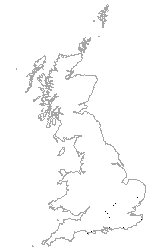 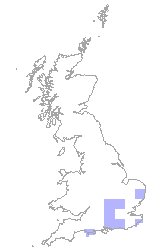
|
| Worldwide
distribution |
Europe
east to the Tien Shan, and possibly east to the Pacific. World
distribution mapped on an equal-area
grid (dark
blue - specimens identified by PHW; light blue - literature
records; white - expected distribution):

|
|
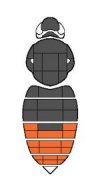
queen/worker
|
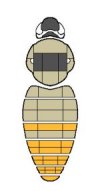
male |
|
|
|
Distinguishing
similar species:
Unlike B. lapidarius
and B. cullumanus, B. pomorum
queens and workers (1) have the head much longer than broad, and
(2) have the mid basitarsi with the posterior angle produced as
a spine (see Løken, 1973);
and males (1) have long antennae and (2) can be distinguished
by their
genitalia.
Unlike
B. ruderarius
and the dark form of B.
sylvarum, B. pomorum queens and workers have the
head much longer than broad (see Løken, 1973);
and males can be distinguished by their
genitalia.
'Apple
Humble-bee'
(Sladen,
1912)
taxonomy
and nomenclature
|
A medium-sized
species with a long tongue, emerging in late spring, nesting
below the surface of the ground. In its nest structure,
it should probably be placed in Sladen's (1912)
group of 'pocket-making' 'pollen-primer' species.
|
| Habitat |
Sand
dunes and marshes (Alford, 1975).
|
|
British
distribution
|
Only
recorded from England (Kent), absent from Wales, Scotland
and the Scilly Isles. It has not been recorded since 1864
and is almost certainly extinct here (Alford, 1975).
Data from Alford (1980)
are mapped on a 10 km grid (left) to show local patchiness
and on a 50 km grid (right) to show changes in the regional
pattern (light blue - pre 1960 only):
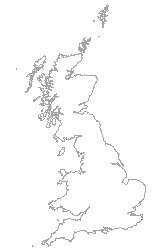 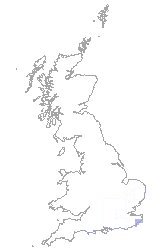
|
| Worldwide
distribution |
Europe
east to Iran and the Urals. World distribution mapped on an
equal-area grid (dark
blue - specimens identified by PHW; light blue - literature
records; white - expected distribution):
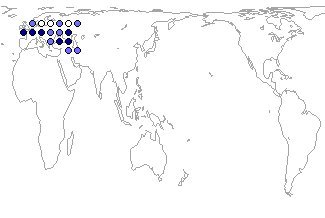
|
alphabetic
British list | distribution
of British species | colour
patterns | colour
diagrams
 top of page
top of page
|